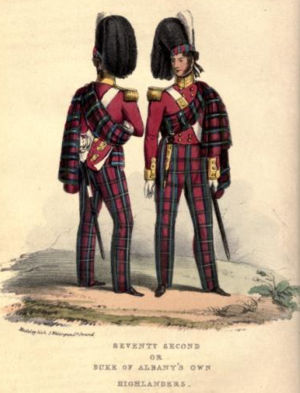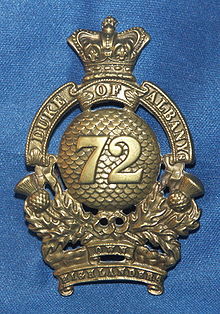- 72nd Regiment, Duke of Albany's Own Highlanders
-
72nd Highland Regiment 
Regimental uniform, 1840sActive 1778-1881 Country United Kingdom of Great Britain and Ireland Branch British Army Type Infantry Regiment Role Infantry Garrison/HQ Fort George The 72nd Highlanders (Formerly 78th Highlanders) was a British Army Highland Infantry Regiment of the Line raised in the late 18th Century in Scotland for service against the French. In 1881 the regiment was linked with the 78th (Highlanders) Regiment to form the 1st and 2nd Battalions of the Seaforth Highlanders.
Contents
Origin and early history
In 1771 the family title of "Earl of Seaforth" was restored to Kenneth Mackenzie after his family had forfeited it because of their involvement in the Jacobite Rebellion of 1715. As a gesture of gratitude, the Earl offered to raise a regiment on his estate for general use by the Crown. The offer was accepted and a corps of 1,130 men was raised. Of these, 900 were Highlanders and the remainder coming from the Lowlands and was located at Elgin, its first base, in May 1778.[1] In August 1778 the Regiment marched to Leith for embarkation to the East Indies– but a dispute regarding their terms of service lead the men to march back to Edinburgh and they took up a position of protest in the vicinity of Arthurs Seat, remaining for several days. During this protest, the men were amply supplied with food and ammunition by the populace of the capital, who had taken side with them in their grievances. After three days of negotiations, compromises were reached and the men again marched from the capital to their quarters at Leith, this time led by the Earl of Seaforth, but the idea of sending them to India now having been abandoned. [Note 1] At this time, the Regiment was designated as the 78th Regiment of Foot.[2]
During the Regiment’s early history they were deployed as follows:
- 1781–1798: East Indies. Embarked on 12 June from Portsmouth with a unit strength of 973 rank and file. Because of change of diet, rough seas and scurvy 274 had died on the voyage and on arrival at Madras on 2 April 1782, only 369 were fit to carry arms. They joined the army of Sir Eyre Coote at Chingleput at the beginning of May but because of their general health, they were considered unfit for service. Those able to wield arms were drafted into the 73rd (Macleod’s Highlanders) Regiment. By October they had recovered their strength and "the colours were once again unfurled" to allow the Regiment to take part in the wars against Tippoo Sahib.[2] At this time, the Earl of Seaforth died and was replaced by Lieutenant Colonel Humberston Mackenzie, who in turn was killed on 7 April 1783 on board the sloop HMS Ranger in action against a Mahratta fleet on his return from Bombay to Madras. He was succeeded by Major–General James Murray.[2]
The men has enlisted for a three year period of service and at the end of this term (1784), most returned to England, save for 425 who elected to remain in India. They were joined by men from other regiments who had also elected to remain on the sub–continent instead of taking their discharge home. This bolstered the regiments number to 700 men. Due to the end of the war with the French, the number of Crown regiments had been reduced and the Seaforth’s designation was changed from the 78th Foot to the 72nd Foot on 12 September 1786[3] In 1789 the war against Tippoo Sahib re–started and the 72nd were to see service in the actions of Dindigul (1790), Palghatcherri (1790), Bangalore (1791), Seringaptam (1791 and 1792), Savendroog (1791)[4] and the 1794 victory over Tippoo which marked the end of the Second Mysore War.[5] The Regiment eventually embarked from Madras back to England on 10 February 1798, being awarded the title "Hindoostan" on its colours.[5]
Timeline
15 May 1778 - 78th Highland Regiment of Foot was passed fit for Service at Elgin, Morayshire
Sep. 1778 ‘Mutiny of MacRaes’ at Edinburgh en route to Channel Islands Garrison


1778-1781 Channel Islands Garrison
Apr. 1779 Repulse French attack on Jersey
Jan. 1781 Help repulse French attack on Jersey
Mar. 1781 To Portsmouth, for sailing to India as part of East India Company Army
1782-1798 India
Mar. 1782 Arrive Carnatic, India. Lose highland dress for tropical service. 250 lost at sea during voyage, including the Earl of Seaforth
1782-1783 Fight at Arnee, Port of Cuddaldore, Fort of Palaghauchterry. Naval Battle
1786 78th Highlanders renumbered as 72nd (Highland) Regiment of Foot when the total number of Infantry Regiments was reduced to 77. As a unit on overseas service the 78th Highlanders were spared disbandment and moved up the order of precedence.
1786 To Mysore, India
1789-1792 Campaign against Tippoo Sultan. Bangalore, Savendroog, Outra Durgam, Seringapatam
1793 Siege and capture of French Pondicherry
1795 Capture of Ceylon from the Dutch
1798 Drafts of men sent to other regiments. Cadre return to Scotland for recruiting.
1798 To Perth. Re-issued highland dress.
1800 To Ireland, as ‘police’ troops.
1805 Capture of Cape of Good Hope from Dutch. Fight alongside 71st and 93rd Highlanders. Lt Col, Grant commanding.
1806 Cape Town Garrison at Wineburg
1809 Re-designated 72nd Regiment of Foot to help with recruiting. No longer authorised to wear Highland dress
1810 At capture of Mauritius from French. Remain as garrison troops.
1814 Return to Cape Town
1815 To Calcutta, India
1816 Return to Cape Town. Remain in South Africa as part of Cape Province Garrison
1822 Return to England
1823 To Channel Islands. Companies split between Guernsey and Jersey.
19.12.1823 - Renamed the 72nd Regiment of Foot, or The Duke of Albany's Own Highlanders. Uniform of Royal Stewart trews and highland bonnet introduced.
Sep. 1824 Return to Scotland for first time in 24 years. Approved the use of the Duke of Albany's cipher as regimental badge
1825 To Ireland. Stationed in Belfast, Londonderry and Dublin
1827 To London
1828 Return to Cape Colony
1834 Xhosa War
1835 To Graham’s Town, South Africa
1838 To Cape Town
1840 To Portsmouth
1841 Royal duties in Windsor
1842 Riot duty in Manchester, Preston, Blackburn and Bolton
Aug. 1842 Five cotton workers killed by 72nd in Preston during protests at wage cuts
1843 To Ireland. Stationed in Dublin, Templemore and Fermoy
1844 To Gibraltar Garrison
1848 To West Indies. Stationed in Barbados, Trinidad, St. Lucia, Demerara, Grenada and Tobago.
1851 To Halifax, Nova Scotia
1854 To Limerick
1855 To Malta
1855 Crimean War
1856 To Aldershot then the Channel Islands
1857 To India via Shorncliffe, Kent.
1858 Arrive Bombay. Indian Mutiny
1859 To Mhow
1865 To Poona
1866 To Edinburgh
1867 To England
1868 To Ireland. Stationed in Dublin, Limerick, Buttevant, Cork
1871 To India, Stationed in Umbella, Peshawar, Nowshera, Cherat, Sialkot
Apr. 1873 Linked Regiments Depot System links the 72nd with the 91st Highlanders at 58th Brigade Depot, Stirling.
1878-1880 2nd Afghan War
1880 To Mean Meer, Lucknow, India
1881 Amalgamated with 78th Highlanders as 1st Battalion Seaforth Highlanders
Notes
- ^ Because of the large numbers of men from the clan Macrae being part of the force, this mutiny became known as "The affair of the Macraes." Ref: MacLauchlan p.525
References
- Lieutenant Colonel Fairrie, Angus. "Cuidich'n Righ": A History of the Queen's Own Highlanders (Seaforth and Camerons). Inverness: Regimental H.Q., Queen's Own Highlanders, 1998
External links
Categories:- Infantry regiments of the British Army
- Highland regiments
- Regiments of Scotland
- Military units and formations established in 1778
- Regiments of the British Army in the Crimean War
- Military units and formations disestablished in 1881
- 1778 establishments in Great Britain
Wikimedia Foundation. 2010.

